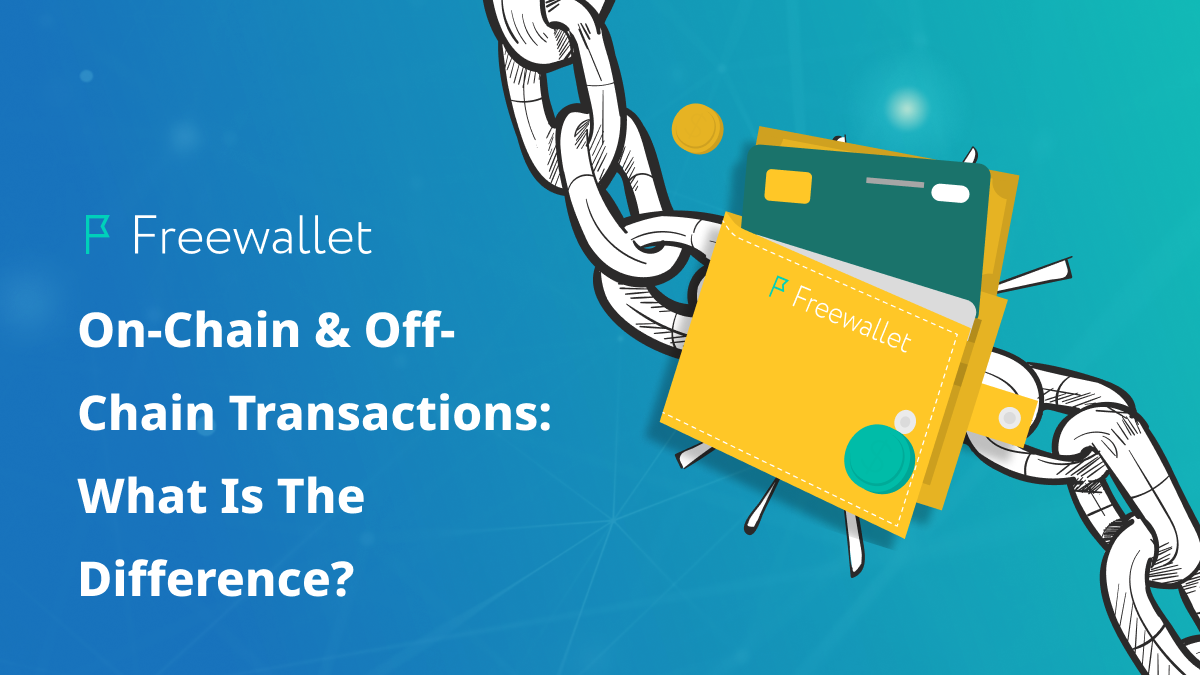
The crypto space doesn’t just include one kind of transaction: in fact, there are different types of transactions referred to as off chain and on chain.
This article will tell you what are on-chain transactions, what are off-chain transactions, and what are the differences between them.
On-chain Transactions
What is an on chain transaction? It’s crucial to understand this topic for all those who want to find out how the crypto system works and why it’s so different from the traditional financial system.
On-chain transactions are probably the most popular type of transactions in the crypto space.
Every time a transaction is made directly on the blockchain of a specific network, it can be considered an on-chain transaction.
How On-Chain Transactions Work?
What does on-chain mean? The name already suggests the functioning of this kind of transaction, but let’s dive into it.
On-chain transactions are slightly different according to the consensus mechanism used by the blockchain.
In order to be recorded on the blockchain, cryptocurrencies need the approval of (at least) the majority of the project participants
For instance, for a crypto like DigiByte (DGB), those who actively participate in the project are miners: in a proof-of-work system, the function of miners is precisely to verify and confirm transactions to create new blocks and new units of the coin.
When a crypto works through a proof-of-stake mechanism, the function of miners is carried out by stakers. In this case, those who need to verify and confirm transactions are stakers who actively mint new blocks. Sandbox (SAND) is an example of a PoS crypto.
So, in both cases, on-chain transactions need the approval of the participants of the same network.
What does enabling on-chain transactions mean? It’s simply the process used by validators and miners to verify each transaction and include it in a block of the blockchain.
Since miners and validators need both time and incentives to work, you need to pay for a transaction to be recorded.
To better evaluate the influence that consensus mechanisms have on transaction cost and speed, a comparison between Cardano and Ether is a good case study.
If you’re wondering what is an on-chain withdrawal or what is an on-chain transaction, always consider that when you find “on-chain” in crypto it’s always referring to this kind of mechanism.
Off-Chain Transactions
Off-chain transactions are different from on-chain transactions: they don’t occur on the blockchain, but still have to do with the crypto space
Off-chain transactions occur when a crypto transaction is not recorded on the blockchain. This can happen in several ways – for instance, instead of moving cryptos from one wallet to another, the two owners give each other their private keys – usually, this or other type of guarantee is used for security reasons.
The value of crypto assets is moved off-chain to avoid additional costs and transaction times.
In some cases, off-chain transactions are just a part of a procedure used to find more scalable solutions, and only the final outcome is recorded on the blockchain.
To give you a practical example, the Lightning Network built for Bitcoin follows this mechanism: this second layer solution uses off–chain channels to perform the majority of operations and and only the final outcome of the payment is recorded on the blockchain.
How Off-Chain Transactions Work?
As we mentioned, off-chain transactions are not recorded on the ledger represented by the blockchain of a specific network.
This has several consequences which are considered to be benefits by off-chain transactions users:
- There are no costs and delays: since there is no need for validation of each transaction, no validators or miners need to be rewarded, and there are no congested blockchains.
- They favor anonymity even more than on-chain transactions. This might seem like a paradox, but the advocates of this point highlight that some elements of the identity of the transactor can be identified if transaction patterns are studied and derived from public data. When using off-chain transactions, people can maintain full privacy.
On-Chain Vs. Off-Chain
Off-chain and on-chain transactions have both advantages and disadvantages.
On-chain (blockchain recorded) transactions are almost irreversible: reverting them is not impossible but it’s harder to revert when compared to off-chain transactions.
On-chain crypto transactions are directly recorded on the blockchain. This makes them tamper-evident and each transaction can be publicly checked – like in the case of Ethereum, since anyone can check transactions on an explorer like Etherscan.io.
Even if this has the advantage of giving proof of what’s going on on the blockchain, it also has disadvantages. The price of each transaction rises due to extracted fees, and delays may occur depending on the blockchain and the consensus algorithm it uses.
Latest transactions on the Ethereum blockchain. Source: etherscan.io
On the other hand, off-chain transactions have no additional cost and they are immediate if you consider the details of their algorithm we provided above.
Nevertheless, both methods can have downsides, especially the ones related to costs and security. Highly congested networks ask you to pay higher fees to execute your transaction, and delays make your transactions less safe.
Security issues can arise also with off-chain transactions – especially because there is the need to rely on a third party.
The Problem with Off-Chain Data
Off-chain transactions have some advantages when compared to on-chain transactions: as we mentioned, no fees and no delays are the main advantages of this kind of operation.
Nevertheless, they also have downsides.
Actually, even when off-chain transactors rely on third parties to guarantee the transactions, it’s far harder to settle disputes. When a dispute occurs, there is no proof of specific transactions indelibly recorded on a public ledger. This means that there is no tool that can be publicly checked – like in the case of on-chain transactions.
This is considered the main issue of off-chain transactions: this system doesn’t possess transparency and lacks one of the main featuresof the cryptosystem based on blockchain technology – the absence of trust.
Like in the traditional financial system, if a guarantor is necessary you’re still relying on a system where the need for trust is fundamental, and this is the very issue that the crypto space wanted to solve since its very beginning.
That’s why all the people who want to learn more about off-chain staking should know that this kind of service is provided by centralized platforms that need to set up internal programs to allow you to earn rewards on assets that are moved to off-chain accounts. In this sense, the procedure is very similar to what occurs with central institutions that manage financial accounts.
Just to recall the well-known words of Satoshi Nakamoto, the traditional financial system still suffers from the inherent weaknesses of the trust-based model.
Bitcoin whitepaper: it pointed out all the disadvantages of an economic and financial system based on trust and provided people with an alternative.
Conclusion
The goal of this article was to answer questions like what are on-chain transactions? And how do they differ from off-chain transactions?
On-chain always refers to transactions that are directly recorded on the blockchain, while off-chain transactions simply move the value of assets off-chain to perform crypto-related operations that are not directly recorded on the ledger.
Even if the presence of off-chain transactions in the crypto space may seem counterintuitive, they have some advantages in terms of costs if compared to on-chain transactions on congested networks. That’s why crypto people are trying to dive deeper into the topic, but it’s worth noting that each trader and investor should always act according to their needs – and not only for cost-driven reasons.
Related
Stay tuned
Subscribe for weekly updates from our blog. Promise you will not get emails any more often.
Most Popular
New Posts
Stay tuned
Subscribe for weekly updates from our blog. Promise you will not get emails any more often.






